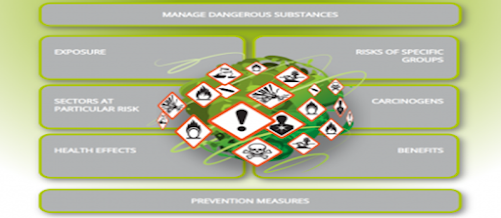Blog title: Here are magical tricks for teaching
a trainee
the right way to handle
appropriately chemical Occupational hazards in the
campus chemical Lab!!
The tricks
that I will reveal to you in the following pages are very useful as far as Occupational
chemical hazards are concerned. The final purpose of this article is allowing
professionals in campuses to safely handle chemical products in their workplace
in campus labs.
First of all, it is important to keep in mind that your campus Lab is not a common room like your classroom or your kitchen at home... Your campus Lab is a professional space like a workshop where a great deal of chemical products is manipulated, used or stocked in protected shelves or closed cupboards.
Nonetheless, I definitely think that it is fundamental for a safe management of Occupational hazards that I insist on the fact that there are chemical products ranged or used in your workplace. Yes, apart from inside the lab, there are some chemical products in the kitchen, in the refectory, in the sport room, and elsewhere in the campus. When your trainee manipulates them iappropriately, such products would be harmful : they could damage their skin. The trainee could expose himself in hight risks of inhaling harmful substances that would attack his piratory organs and gravely damage his health. This is why I would strongly recommend getting precautious about chemicals especially during the internsphip. you would train them to use the Individual Protection Equipment (IPE).
By the way, when the sanitary Board makes a request, article R. 4624-4-4 of the Labor Code imposed to any employer to show the safety data Sheet of the chemical products they are using in the Lab or firm. My purpose in tackling this issue in my blog is to enhance a safe practice concerning chemical Occupational hazards Management in campus laboratories. Chemical substance is not systematically dangerous. However, it becomes so, when it is not handled with appropriate manners. When it enters in our body through the skin, or the other ways such as the breathing or inhalation or ingestion, it mixes with the blood and disperses throughout the body. Finally, it becomes harmful for the vital organs. In addition, chemical hazards damage our environnement through pollution.
SOURCE : https://osha.europa.eu/en/tools-and-resources/infographics
From that point, there are several reasons why you should respect accurately the Occupational Exposure Limit Value (OELV[1]) in your workplace. However, that limit value is different according to domestic regulations of the European Union member countries. If you want useful information about Occupational Exposure Limit Value in France, visit the following link: http://www.inrs.fr/media.html?refINR=outil65.
Furthermore, there is a wide range of useful information on Occupational limit value of European countries in the following website https://osha.europa.eu/fr/themes/dangerous-substances. As I am absolutely sure you are wondering how to appropriately handle the internship of your trainee as far as chemical hazards are concerned, you could find other useful advices at the following link: www.inrs.fr/publications/bdd/biotox; and in this yearly published guide entitled Guide to Occupational Exposure values, ACGIH. Your can find this useful document by typing its title in a research website such as google.
If you want to know the OELV of any
given chemical substance, you would find that information in the eighth rubric
of the safety data Form. By the way, you might find instructions about
occupational exposure by inhalation in the norm NF EN 689: Occupational
chemical exposures.
I mentioned early that great
quantities of items containing chemical products are stocked in your Lab
Campus. You have to understand that such items should not be stocked like any
common items. When you don’t take particular precautions in putting in place a
safe stockage strategy, your lab could explode making your trainee fly away in
great speed to the skies before the end of the internship.
I am sure that you want to get the magical trick that would help you avoid such mischief., you might absolutely know that all chemical products are not compatible with one another. Therefore, when you keep stocking together conflicting chemical products, there will be explosions and fires in your Lab. So, before putting in place any plan of receiving new delivery of items, you should smartly read and understand rubrics seven, nine and ten of the SDS of all the new items you are receiving. You should also undertake preventive actions limiting damages in case of fire of explosion of your lab. For that purpose, you should put in place airing by aspiration devices so that pure air could be permanently renewed inside your campus Lab.
If you want to get additional helpful information about safe manipulation and stockage of your chemical substances while your trainee is with you in your Lab, read the following documents in French from the National Institute of Research and Safety (NIRS):
-
ED 6015 Le stockage des produits chimiques au
laboratoire
-
ED 753 Stockage et transfert des produits
dangereux.
You could easily find and download
these two papers and many others about Occupational safety and Occupational
chemical hazards from the website of the NIRS.
In summary, reading this blog enables
anyone to manage safely hazards related to chemical substances and products.
The main rule to keep in mind is to have a comprehensive chemical Occupational
hazard management. That management starts from putting in place an efficient
airing system, and reliable and appropriate individual protection equipment
according to the activities the workers are executing. The last rule to
remember about is to arrange a compatible storage system.
[1] National Institut of
Research and Safety (NIRS) means Institut National de Recherche et de Sécurité
[1] Occupational Exposure
Limit Value (OELV) means Valeur Limite d’Exposition Professionnelle (VLEP)







Aucun commentaire:
Enregistrer un commentaire